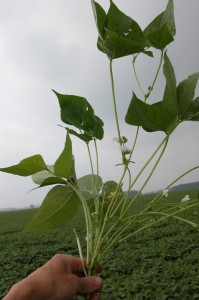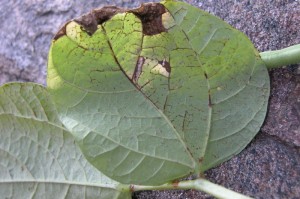SYNOPSIS
Majority of edible beans are in late vegetative to early flowering. The crop in many areas looks excellent. Recent heavy rains and saturated soils raises the risk of white mould, anthracnose in white and black beans and root rot. Leafhopper populations have been low up to now.
White Mould :

50% Flower Stage, first pin beans evident
Fungicides to protect against mould need to target beans at 30% (5 open flowers) to 50% (2-3 pin beans) flowering stage The greatest economic losses from white mould occur from infections during early flowering that infect main stem. Fungicides for anthracnose and white mould control provide 10-14 days protection. Greatest risk factors for both diseases is good soil moisture in the 2 weeks prior to flowering, dense crop canopy, and rainfall and a wet canopy for 2-3 days during flowering. Dry weather and temperatures over 28 0 C limit infection. Fungicides need to be applied prior to signs of infection become evident. Sprays should target thorough coverage of flowers and foliage.
Prescence of apothetia on soil surface that discharge mould spores can confirm white mould risk, but can be difficult to find (Figure 1)

White Mould Apothecia
Anthracnose:

Red – Purple discolouration of Leaf veins and petioles
Anthracnose can develop quite rapidly under moderate temperatures (250 C) and with driving rains, which spread the disease. Anthracnose often first appears in areas of field where water flows, headlands, and low lying or along fence rows. Signs first appear as red-purple veins on backs of leaves and petioles(stem that is attached to the leaf). Anthracnose can develop quite rapidly under moderate temperatures (250 C) and with driving rains, or running water, which spread the disease.
Root Rot:

Yellow discolouration of lower leaves and redish brown roots
Stress on edible beans from excess moisture and root rot are very evident as very uneven growth, yellowing of plants, and brown discolouration of roots. There is no good control for root rot once plants are infected. Infected plants try to compensate by producing new lateral roots above the existing root system. In wide row beans where the harvest method is pulling and windrowing, inter-row cultivation to hill up loose soil around plants can help. Foliar fertilizer can provide temporary relief from poor functioning root system, but there have been few trials to support its use. Applying a small amount of nitrogen fertilizer (20-40 lb N/ac) may help stimulate new root development, particularly where nitrogen was lost from excess rainfall. Higher rates of nitrogen can stimulate heavy vine development and create conditions for white mould.
Source: Fieldcropnews